
"Will you marry me?" Jenny Malott gets that a lot. Comes with the territory, really. When you look like a professional football cheerleader, and act like one, and show up to actual professional football games alongside two dozen other young women dressed like one -- wearing silver knee-high boots with pleated blue miniskirts and matching, ab-revealing half-tops, color-coordinated pom-poms in tow -- people tend to behave accordingly. Guys, especially. They profess their undying love. They ask for your hand in blessed matrimony. They chant your group's name: De-troit Pride! De-troit Pride! Mostly, people ask for pictures. Hundreds of pictures, during each Detroit Lions home contest, inside and outside Ford Field, with excited little girls and embarrassed teenage boys and very excited young men, digital cameras beeping and flashing. Pictures until your face hurts from smiling so much. Pictures that are unique, yet in one way all the same.
"We always stand with our shoulders back and put our pom-poms on our hips, throw our elbows out a bit," Malott says. "Say some drunk person wants a picture and wants to hug you. We're not allowed to do that. If they're pulling you in and your elbows are out, they can't really go anywhere."
And that works?
"It's not like you're elbowing them."
Malott laughs. She sounds like an old pro. In reality, she's anything but. A 23-year-old recent college graduate, Malott is a member of the Detroit Pride, the unofficial cheer squad of the Lions. Unofficial, because unlike the Dallas Cowboys and the Oakland Raiders and all but five other NFL teams, the Lions don't have cheerleaders. Not yet. The Pride hope to change that. A do-it-yourself group of like-minded aspirants, they want to be sanctioned by the club. Someday. For now, they live in a kind of pep squad shadow world, the equivalent of a wannabe pastry chef who shows up for dinner at a restaurant, starts cooking crème brulee at his table and patiently waits for the place to hire him. Just like official squads, the New York Jets Flight Crew and the Buffalo Jills, Malott and her teammates practice dance routines. They make public appearances. They have a choreographer, hair and makeup artists, their own security detail. They even have a swimsuit calendar.

Eight times last fall, they bought tickets to Lions games, mingled with tailgaters, danced to the strains of "Party Rock Anthem" at nearby Eastern Market. They then filed into Ford Field, where they sat in the stands and cheered for the home team, just like any other group of fans. Well, except for the marriage proposals. And also the one question Malott doesn't know how to answer.
Why aren't you on the field?
"It's the hardest thing to explain," Malott says. "The truth is, I don't really know."
A recent Tweet from Kelly Hall, former Georgia cheerleader and current girlfriend of Lions quarterback Matthew Stafford:
"All @Staff_9 wants for xmas is the playoffs. But all I want is cheerleaders on the sidelines. Whats football w/o cheerleaders?!"
Ten years ago, the expansion Houston Texans publicly introduced their cheer squad. Before the team had any actual NFL players. By doing so, they confirmed a fundamental axiom of modern life: In Texas, there is no football without cheerleaders. Not so in Michigan. Since moving from Ohio to Detroit in 1934, the Lions have never fielded a cheer team. Not when the Cowboys cheerleaders revolutionized the gig in the 1970's, blow-dried beauty queens who high-kicked like Rockettes, bringing fresh-scrubbed sex appeal to the grim and grimy pro football sideline, ascending to a place in the pop culture firmament between the Sports Illustrated Swimsuit Issue and the Miss America pageant. Not when just about every other team and league in sports -- the NBA and minor league hockey, arena football and the XFL, even Olympic beach volleyball, which in a mobius strip-like twist has bikini-clad cheerleaders rooting for bikini-clad athletes -- followed suit. Oh, sure: At the old Pontiac Silverdome, the Lions had high school cheerleaders handing out programs on the stadium concourse, and four lonely baton twirlers performing in each corner of the field. But otherwise, zilch.
What's football without cheerleaders? It's the Flyin' Lion, an inflatable, remote-controlled airborne mascot, floating above the Silverdome crowd, dropping the occasional Kmart gift certificate.
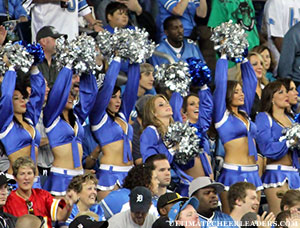
Andrea Wilamowski took notice. She wanted more. A 40-year-old Michigan native and former high school cheerleader who spent eight years writing and recording country music in Nashville, she found herself at a 2008 Lions game with her husband, Mark, a fellow diehard fan and longtime season ticket holder, sitting through a commercial break, staring at the overhead screen. Fifteen seasons of sideline monotony washed over her, a great big tidal wave of blah. "It was so absolutely boring, with nothing going on," Wilamowski recalls. "It's a serious problem when a giant cup of coffee and a doughnut are getting thousands of cheers."
Right then and there, she made up her mind. Cheerleaders. It was time. Beyond time. The Lions would finish the season 0-16. Detroit's economy was flatlining. Following the resignation and incarceration of ultra-corrupt mayor Kwame Kilpatrick, local politics had become a national punch line. The team needed a boost. The city, too. Cheerleaders. Wilamowski called a friend, Stacey Latona, who worked in radio and sports marketing. The pair spent months researching the pro cheerleading industry: Watching videos, visiting teams, talking to cheer squad directors. They drew up a business plan. Reached out to potential sponsors. Consulted with Angela King, the queen -- make that dean -- of NFL cheerleader uniform design. In late 2009, they contacted a friendly front office executive with the Lions: Can we have five minutes of your time to make a pitch?
Not now, the executive said. Call again in March.
March came. Another call.
Thanks, the executive said. But no thanks.
"Stacey and I said, 'let's do it anyway,'" Wilamowski says. "I love the Lions -- God help me – and I wanted to be a part of turning the team around. We had a losing team for umpteen years. It's not the curse of Bobby Layne."
Layne, a former Detroit quarterback, supposedly said the team wouldn't win for 50 years after trading him to Pittsburgh in 1958.
"No, it's the friggin' curse of no cheerleaders," she continues. "The curse of no entertainment. The fans are screaming for something, and the team won't give it to them."
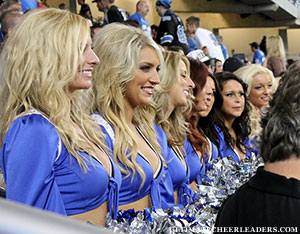
The Detroit Pride were born. Wilamowski and Latona formed a company. Put out a press release. Held auditions at a local dance studio. Their email exchanges with the Lions, once friendly and informal, became stilted and terse. Was the organization upset? Spooked? Lawyering up? Rumors swirled. "I didn't want to tick the Lions off," Wilamowski says. "I wanted to work with them."
In August of 2010, 12 women were selected for the inaugural cheer team -- all students and young professionals, many of them frustrated by the lack of dance opportunities in Detroit. A month later, they made their Ford Field debut, showing up in full uniforms, enduring security pat downs just like regular fans, operating under a strict set of team-imposed rules:
** No performing organized cheers.
** No obstructing fan views.
** No taking group photos with fans.
** No wearing Lions logos or team colors, including "Honolulu blue."
A few games into the season, Wilamowski noticed something else: Camera operators apparently were prohibited from showing the Pride on the stadium video screen. Case in point? During a Halloween contest between the Lions and the Washington Redskins, four members of the squad wore referee costumes. The rest dressed in their regular cheer outfits. When the sexy refs appeared overhead, fans began shouting. De-troit Pride! "Then they panned from the referees to our other girls and realized what was happening," Wilamowski recalls. "Boom! The camera drops down to the turf. You just saw the cameraman's feet. Everyone was booing."
Technical malfunctions aside, reaction was mostly positive. Fans flocked for pictures, offering encouragement. "They're well loved," says Lions fan Ron Crachiola, a season-ticket holder for 33 years. "We've wanted cheerleaders for years, especially when the team wasn't playing well."
Lions players privately voiced their approval; when the Pride were given front-row end zone tickets from a group of supportive tailgaters, members of Detroit's kickoff unit high-fived the women. Beyond Ford Field, the Pride visited a V.A. hospital on Veterans Day. They spoke at schools. They began making regular promotion appearances, adding four members in-season to keep up with growing demand. Wilamowski and Latona were losing money, covering most of the organization's costs out of pocket. "Every week we go to the games, we pay at least $1,500-$2,000 for tickets," Wilamowski says. "And the girls all want to eat." Still, the pair felt they were on the right track. During the off-season, they contacted the Lions, this time with an offer.

If we purchase $50,000 worth of tickets to a preseason game, can we come onto the field to perform a routine? One minute. During halftime. Alongside 150 junior cheerleaders from our summer youth camp.
The Lions said no. Undaunted, Wilamowski emailed back.
How about $100,000 worth of tickets? I have a sponsor willing to pay half of that, and the girls on the team will pay the rest.
No answer.
Cheerleading Facts That May Or May Not Be Entirely Coincidental, Vol. I: The five other NFL franchises that don't have cheerleaders -- the Chicago Bears, Cleveland Browns, New York Giants, Green Bay Packers and Pittsburgh Steelers -- have won four of the last six Super Bowls.
This is how Lions senior vice president of communications Bill Keenist replies when asked about the Pride: "We believe that nothing is more important to our fans than a winning product on the field. Consequently, our primary focus will always be on the football team." It's a canned quote, prepackaged public relations filler, relayed via email, pretty much the same thing the franchise always says when queried about its lack of cheerleaders. Sounds reasonable. Conveys almost nothing. Leaves Terry Foster perplexed. Foster is a Detroit native, a man who grew up on the west side of the city and went to Cass Tech high school. He gave local basketball star Robert "Tractor" Traylor his nickname. As a longtime sports writer and columnist for the Detroit News, Foster has called for the Lions to add a cheer squad in print; as an afternoon talk radio host, he has heard countless callers demand the same.
"In fairness, now and then, I do hear from guys who are traditionalists, who say it's about football and entertainment," Foster says. "But we've had entire shows about cheerleaders. You get very few callers saying they don’t want them. Instead, we get into what people want them to wear, what people want them to look like."
Foster laughs.
"It's not a debate if we should have cheerleaders or not. It's if they should be in bikinis or more tastefully clad."
Perhaps that's the problem. Since the Lions never have fully explained why they don't have cheerleaders -- does anyone believe that New England's dance squad makes Robert Kraft and Bill Belichick any less focused on winning football games? -- rumors abound. Foremost among them? The Lions are prudes. Well, not the team per se. More like ownership. Specifically, the wife of owner William Clay Ford Sr., Martha Firestone. "There's a big theory that she doesn't want cheerleaders and as long as she's around, the Lions will never have them," Foster says. "It's an urban myth, but I sort of believe it."
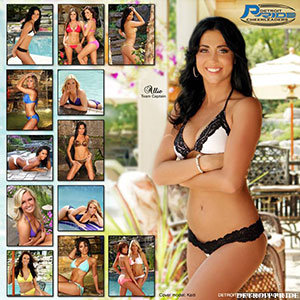
But didn't the Lions used to have high school cheerleaders at their games?
"Everyone kind of made fun of that," Foster says. "To me, that was embarrassing. You'd get these drunk guys at the Silverdome, and then have all these 16- and 17-year-old cheerleaders out there for them."
Wilamowski and Latona hear the chatter, both from fans and from sources within the Lions organization. As such, they've done everything they can to limit the Pride's cheesecake quotient. The squad's first-year uniforms were boy shorts and sporty half-shirts, showing about as much skin as a typical cardio-kickboxing outfit. Their inaugural calendar depicted the team's members fully clothed, a far cry from the Philadelphia Eagles cheerleaders' well-known, barely-there swimsuit and lingerie calendars. Performers like Malott were selected as much for their personalities as their looks and dancing ability, something Foster discovered when he attended one of the Pride's first rehearsals.
Bubbly and positive? In.
Vampy and suggestive? Way, way out.
"Honestly, I didn't go in with high expectations," Foster says. "I thought it would be a couple of strippers, people with no education. But they were educated. They were dedicated." A subsequent day at Ford Field was more of the same. "Guys wanted photos and autographs, but it wasn't an ogle-fest where things got out of hand," he adds. "It was very reserved, 'I hope to see you guys on the field,' that kind of talk. The girls like to entertain, be in front of people. But my understanding just from talking to them is that they want to be the legacy group for this, the group that says, 'we were the first.'"
Cheerleading Facts That May Or May Not Be Entirely Coincidental, Vol. II: In 1985, the Bears won the Super Bowl. They promptly disbanded their cheer squad, the Honey Bears, reportedly because team owner Virginia McCaskey considered them to be sex objects.
The team hasn't won a championship since.
Game days are the longest. Kaiti Nester wakes up at 3 a.m. Some of her peers are still out partying; some are heading home from the bar where she works. A 22-year-old senior at Michigan State University, she takes a shower, hops into her bright orange Pontiac hatchback, sticks a self-burned CD into the dashboard stereo system. Most of her Detroit Pride teammates favor dance music. One listens to audio books. Nester likes Motown. From East Lansing, it's a 90-mile drive to Detroit. Nester makes the trip a few times a week, attending team workouts and public appearances, like the one last October when the Pride unveiled their new swimsuit calendar. Nester was on the cover, wearing a gold bikini. That was a nice surprise. Of course, nice surprises don't cover her gas bills, which total "a few thousand." They could be worse. "My car gets great mileage," she says. "Thank goodness."
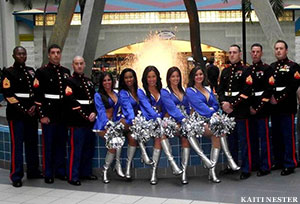
In high school, the 5-foot-10 Nester was jock, a high jumper and 4x400m relay runner. She also was a competitive cheerleader. Her father played football at Michigan State and was drafted by the Cowboys. "That's why I became a cheerleader in the first place," she says. "If I couldn't play football, I wanted to be as close as possible, follow in his footsteps in my own way." A health major, Nester wants to become a nurse. When she went to college, she gave up cheerleading, doubled down on studying, figured her performing days were over. Then she heard about the Pride. Eight Sunday mornings last fall, Nester found herself inside a suburban Detroit beauty salon at 6 a.m., getting her hair and makeup done alongside her teammates -- a dog groomer and an emergency room technician, a senior project manager and an aspiring police officer, all of them doing this on the side, mostly on their own dimes. The Pride cheerleaders earn $50 a game, a little less than their sanctioned NFL counterparts. No one in the business gets rich. "We're not divas," Nester insists. "I'm a nerd. Most of the people on the team are goofballs. We're all just students and workers."
Work is the operative word. Game days mean taking pictures, selling calendars, performing full, choreographed routines outside Ford Field. "I think they have a much longer day than the average NFL squad," says Dave Nelson, the Midwest correspondent for a pro cheerleading website. "You never see a squad spending 8-9 hours in uniform like they do." This is the fun part. The rest of the week means working out. Working on dance moves. Watching what you eat. Watching your posture. Keeping your hair a certain length. Keeping current on the Lions, in case anyone asks about the team. Practicing your smile.
"You don't just show up to games," says Pride captain Shannon Brown, a 24-year-old bank customer service rep who lives in Bay City, Mich., about two hours from Detroit. "There's a lot of behind the scenes things. But you get used to it. It's a lifestyle." Nester knows. Before auditioning for the Pride, she stopped drinking alcohol. Started drinking lots of water. Changed her diet to mostly fruits and vegetables. Took dance classes. Went to kickboxing twice a week. During football season, she sometimes worked out twice a day. She lost money, hardly saw her college friends. And yet: After she graduates this spring, she plans to move closer to Detroit, the better to continue with the Pride. Why bother? "It's hard to explain," Nester admits. "My friends and family are proud of me, but they don't really understand it."
Jay Howarth does. A Los Angeles-based sports and entertainment producer, she founded the Denver Broncos cheerleading squad and later produced cheer teams for NFL Europe and the short-lived XFL. Howarth grew up in Michigan. She consults with the Pride. Long before she became a professional pom-pom whisperer, she was a cheerleader herself, a member of San Francisco's first-ever squad. Make that trial squad. In 1981, the 49ers were an up-and-coming team, looking to bolster their home field advantage. Unsure if their famously urbane fans would accept cheerleaders, they enlisted a group of college-age California cheer camp instructors to test the concept. Howarth was on the team. So were Paula Abdul and Teri Hatcher. Clad in long-sleeve turtleneck sweaters, they made their sideline debut during the 1982 NFC Championship game at Candlestick Park. Which is how Howarth ended up near the end zone, watching 49ers receiver Dwight Clark sprint toward her before twisting and leaping for a last-minute, game-winning fingertip touchdown grab forever immortalized at "The Catch."

"That play haunted me for a long time," she says. "I thought it was magic. I wanted more than anything to have a connection to that." Howarth moved to New York and studied acting. She appeared on the television shows "Coach" and "Picket Fences." She never lost her passion for cheerleading. Over time, she realized it was a wholly American art form, like square dancing and jazz, a kind of performance that could create a magic all its own, focusing and directing a crowd's energy, anchoring the lurching, stop-and-start flow of a pro football game.
"Think of games that come to a fever pitch and then go to a commercial, killing the buzz in a stadium," Howarth says. "You can't have that. The cheerleaders put on some music. They dance. They keep that energy going to the next play. That matters. I'm telling you, the home team can feel it. Players are like dancers. They feed off that energy."
So it's not just cheesecake?
"Cheesecake? Oh, no. We're way past that."
Maybe the Lions are unduly prudish. Or maybe they're simply being prudent. Adding a cheer squad is no small thing. From a operations perspective, it means juggling sponsors and rearranging game day stadium scripts, introducing a brand-new element that somehow has to feel like a 25-year-old tradition; from an image standpoint, it means something else. Risk. Ours is a digital era, scandal moving at download speed. Misbehaving cheerleaders can embarrass a franchise as much as misbehaving players: See the two Carolina Panthers cheerleaders who were kicked off the squad in 2005 for allegedly having sex in a bar bathroom stall, igniting a firestorm of national headlines and late night talk show gags. Like other cheer teams, the Pride have strict rules: No swearing, drinking or smoking in uniform. And no doing anything stupid out of uniform, either. "People associate what you're doing in your personal life with what you're doing as a cheerleader," Brown says. "We have to be very careful."
On the other hand, a cheer squad can be the most cost-effective public relations tool imaginable. During the season, players are available for community and charity events on Tuesdays, assuming they aren't injured, shy or surly. Cheerleaders are available every day of the week, every week of the year. Always with a practiced smile. "Every pro cheer team does dozens of community appearances a year," Howarth says. "They make it a show, give you a home field advantage. You get the energy unique to a sporting event. You have 30 women on your team, you increase you ability to connect with and touch the public exponentially."
Just ask Larry Johnson. A 49-year-old retired mailroom supervisor from Richmond Heights, Ohio, he suffers from ataxia, a rare medical condition involving severe, debilitating migraines and dizzy spells. Sometimes, Johnson throws up. Other times, he's unable to walk or speak. He can't predict exactly when an attack will take place. But he knows the warning signs. His eyes blink uncontrollably. His legs start to get weak. "Normally, I know when I wake up in the morning how it's going to be," he says. The condition forced Johnson to stop working. It limits his life. Football is his salvation. Cheerleaders are his salvation. Since the mid-1980s, Johnson has been taping NFL games, cutting his own highlight packages -- a safe activity, and a way to keep up with the sport, even if your next three hours might be spent in a dark room. A few years ago, Johnson started splicing cheer videos, too, collecting pictures of himself with cheerleaders the way other people collect stamps. He was drawn to the bright smiles, the positive vibe. It got him out of his apartment and out of a deep funk, even helped him lose weight. When he discovered the Pride on Twitter, he decided to make a pilgrimage, driving to Detroit with a friend, Maria, a former Cleveland Cavs dancer. The two arrived on a game day, parked across the street from Ford Field. They met the Pride at a nearby restaurant. Johnson took a picture with the entire team. He keeps it on his cell phone. "It was a perfect day," he says. "I couldn't believe how nice the girls were to me. I hope they become an official squad."
The craziest thing about the trip? Johnson isn't even a Lions fan. He roots for the Minnesota Vikings.
Late in the 2010 NFL season, the roof of Minneapolis' Metrodome partially collapsed following a heavy snowstorm, forcing the Vikings to play a hastily arranged "home game" against the Giants at Ford Field. The contest took place on a Monday night. The Vikings brought their regular cheer squad. When the women stepped on the artificial turf -- the first professional cheerleaders ever to do so -- the building erupted. "A huge cheer," Foster recalls. "People were so excited." In her seat, Wilamowski was in tears. Latona could hardly bear to watch. They didn't bring the Pride to the game. It would have hurt too much. "Andrea wanted her girls to be the first," says Wilamowski's husband, Mark. "But by the time we left, you could see that the crowd's reaction validated what she's doing. I think it made her more determined."
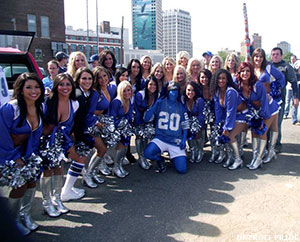
In the last year, the Pride have hired a professional choreographer and the former director of the Detroit Pistons dance team. They attended a summer pro cheerleading camp, mixing with and learning from official NFL squads. Increased sponsorship and frequent public appearances have made the group financially self-sustaining; recently, another cheerleader-free pro football team contacted Wilamowski and Latona about creating and managing a test squad. "I think the appeal to them is that it's like the rogue cheerleader," Latona says. "People embrace the underdog aspect of it."
Still unofficial, Brown and her Pride teammates nevertheless feel more and more like real cheerleaders. "At the beginning, the fans we had to sit in front of would complain, because we would stand up and cheer," she says. "Now, the whole sections we sit in will stand up and cheer, too."
Most evenings, Wilamowski sits in front of her computer, well past midnight, managing Pride affairs. She's optimistic. Says she's had private conversations with people who work for the Lions. Everything is positive. A bonafide pitch meeting is just around the corner. So she hopes. Foster remains dubious. He knows the Lions, knows the weight of history. "I believe that door is shut," he says. "It isn't dead-bolted, but I think they're positioning themselves for something that's 5 to 10 years down the road. Part of me feels sorry for them."
At games, Foster sees the Pride in the stands, all dressed up with no place to dance, the cheerleaders who aren't. So close to their goal, and yet so far. "To see a cheer team sitting there and not on the field is sort of like a NFL player on injured reserve," he adds with a sigh. "When is she going to get into the lineup?"







